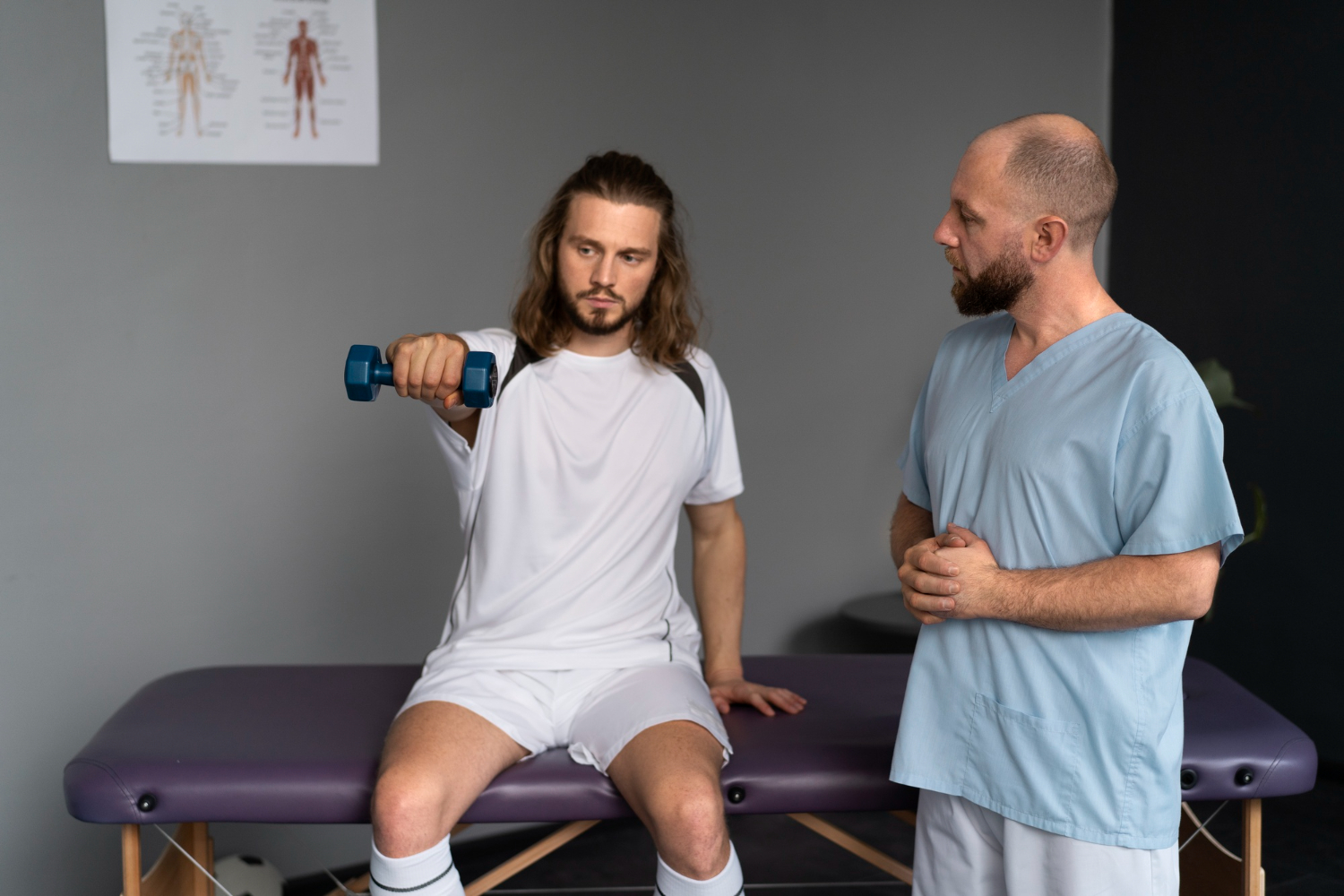Synopsis
Pain in the arm or shoulder can stem from various causes—poor posture, repetitive stress, sports injuries, or even post-fracture complications. Fortunately, with the right combination of physiotherapy for arm pain and physical therapy for arm and shoulder pain, lasting relief and functional recovery is possible. This blog explores how arm physiotherapy, especially when focused on physiotherapy for shoulder and arm pain, can help rebuild strength, restore range of motion, and prevent recurring discomfort.
We highlight the specific benefits of physio for arm and shoulder pain for office-goers, athletes, post-operative patients, and the elderly. From managing rotator cuff injuries and upper arm muscle pain to treating frozen shoulders and mobility restrictions, targeted physio exercises for upper arm muscle pain ensure holistic recovery. Whether it’s acute pain from a fall or chronic stiffness from long-term neglect, structured therapy ensures safe, progressive results.
Working with a qualified arm physio is key to understanding movement dysfunctions and correcting them through evidence-based exercises and therapeutic techniques. The goal isn’t just pain relief—it’s regaining full functionality, improving posture, and enhancing everyday movements without discomfort.
Table of Contents
Introduction to Elbow Physiotherapy
- Understanding the Source of Arm and Shoulder Pain
- Why Physiotherapy Works for Arm Discomfort
- Common Causes of Shoulder and Arm Pain
- Techniques Used in Arm Physiotherapy
- Key Exercises for Upper Arm Muscle Pain
- Benefits of Physical Therapy for Arm and Shoulder Pain
- Recovery Milestones and Safety Tips
- How Orthocure Provides Expert Arm & Shoulder Physiotherapy
Understanding the Source of Arm and Shoulder Pain
Shoulder and arm pain can originate from muscles, tendons, ligaments, nerves, or even spinal misalignments. Understanding the root cause is crucial. Physiotherapy for arm pain begins with a thorough assessment to determine the underlying issue—be it muscle strain, nerve impingement, or postural misbalance.
Why Physiotherapy Works for Arm Discomfort
Physiotherapy addresses pain and its causes with manual techniques, exercises, and therapeutic modalities. Unlike temporary relief through medication, physical therapy for arm and shoulder pain focuses on long-term correction. It improves circulation, strengthens supporting muscles, and promotes natural healing pathways without side effects.
Common Causes of Shoulder and Arm Pain
Overuse, incorrect lifting techniques, frozen shoulder, rotator cuff injuries, and cervical spine issues can all cause arm or shoulder pain. Poor ergonomics in desk jobs and sedentary habits worsen these conditions. Physiotherapy for shoulder and arm pain targets these factors to reduce inflammation and improve movement
Techniques Used in Arm Physiotherapy
Arm physiotherapy involves a blend of soft tissue release, mobilisation, dry needling (if needed), and resistance training. Ultrasound therapy and electrotherapy may be used for inflammation control. Taping and posture correction are employed to support muscles during recovery. Each plan is customised per the patient’s severity and goals.
Key Exercises for Upper Arm Muscle Pain
Physio exercises for upper arm muscle pain focus on eccentric and isometric contractions, scapular stabilisation, and controlled stretching. Resistance band curls, wall push-ups, pendulum swings, and active range movements help rebuild strength gradually. Supervised progression prevents re-injury and ensures functional recovery.
Benefits of Physical Therapy for Arm and Shoulder Pain
Improved joint mobility, reduced pain, restored muscle coordination, and better posture are key benefits. Physio for arm and shoulder pain also helps improve sleep, mental health, and independence in daily activities. Regular therapy significantly decreases the risk of chronic conditions like frozen shoulder or tendonitis
Recovery Milestones and Safety Tips
Recovery depends on injury severity and consistency in therapy. Milestones typically include reduced pain within two weeks, improved mobility by week four, and return to full function in 6–10 weeks. Patients should avoid sudden arm movements or lifting until cleared by their arm physio. Gradual reintroduction of activities is essential.
How Orthocure Provides Expert Arm & Shoulder Physiotherapy
At Orthocure Clinics and Gyms, physiotherapy for arm pain is conducted using advanced tools, experienced therapists, and global treatment protocols. Our team diagnoses and designs personalised plans combining manual therapy, strengthening machines, and ergonomic corrections. Patients benefit from medical oversight, progress tracking, and holistic recovery under one roof. Our focus is not only on healing but also on prevention, helping clients move freely, confidently, and pain-free.
FAQs
What causes pain in the upper arm and shoulder region?
Pain can result from overuse, muscle strain, postural issues, nerve compression, or joint dysfunctions. Activities like long hours at a desk, sports injuries, or repetitive tasks may lead to such discomfort. Identifying the exact cause through a clinical assessment helps in designing an effective physiotherapy plan. Early intervention prevents chronic stiffness. Accurate diagnosis is key to successful recovery.
How does physiotherapy help with arm and shoulder pain?
Physiotherapy improves circulation, corrects muscle imbalances, and strengthens the affected area. It uses mobilisation, therapeutic modalities, and tailored exercises to relieve pain and restore function. Unlike temporary painkillers, therapy addresses root causes for lasting relief. Customisation ensures optimal progress. It’s a drug-free and evidence-based treatment method.
What exercises are recommended for upper arm muscle pain?
Common exercises include wall slides, resistance band extensions, shoulder shrugs, and scapular squeezes. These aim to strengthen deltoid and rotator cuff muscles while improving flexibility. However, exercises must be prescribed by a qualified therapist to avoid aggravating the condition. Progress should be gradual. Warm-up and cool-down routines are also important.
How long does it take to see improvement with physiotherapy?
Improvement can be seen within a few sessions, especially for mild conditions. Significant relief often occurs by the third or fourth week. Severe or chronic issues may take longer, up to 8–10 weeks. Consistency in attending sessions and following home care advice speeds up progress. Recovery is also influenced by lifestyle and underlying health factors.
Can I do physio for arm and shoulder pain at home?
Yes, once initial guidance is provided, many exercises can be done at home. However, periodic sessions with a professional ensure you’re progressing safely and correcting posture or movement faults. Home routines must be monitored. Improper execution may delay or worsen recovery. Clinic-based therapy offers personalised corrections and technology-assisted care.





